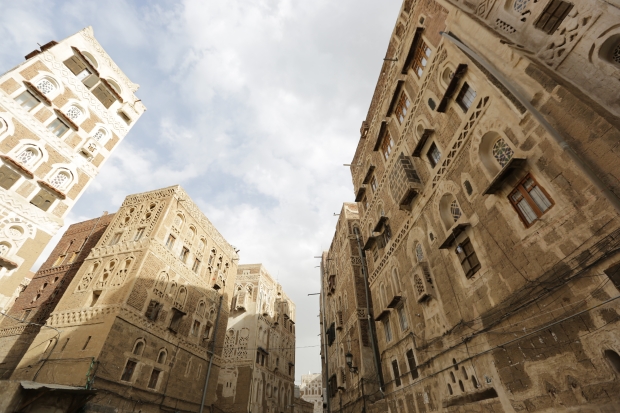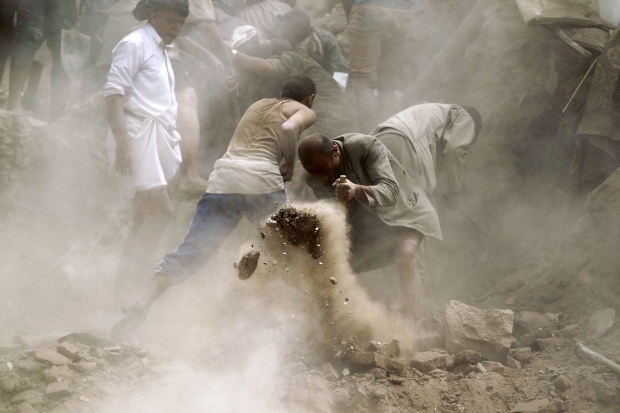
Award-winning journalist Peter Oborne and Middle East Eye’s Nawal al-Maghafi are among the few correspondents to have ventured into war-torn Yemen during the past few weeks. Much of their reporting is from Houthi-held territory, where they were accompanied and their interviews monitored by Houthi minders. We are, however, confident that what they were told by their interviewees is authentic.
SANAA - Saudi bombers have not merely targeted civilians during the 18-month war in Yemen. They have struck time and again at the country’s thrilling architectural heritage, inflicting untold destruction.
Not even the old city of Sanaa, continuously inhabited for more than 2,500 years and a UNESCO world heritage site, has been spared. Its old quarter, which is every bit as as priceless and unique as those in European cities such as Venice and Florence, has also been targeted by planes from the Saudi-led coalition.
We spoke to Yemen’s director of antiquities, Mohannad Ahmad al-Syani, who graduated in archaeology from the University of Sanaa 30 years ago. He told us that “75 archaeological sites have been hit by the Saudi-led coalition or bombing by al-Qaeda”.
https://www.youtube.com/embed/EoZsjagnKPs
He accused Saudi Arabia of destroying ancient sites that have played no military role. “These are not places where you can hide weapons or militants,” he said, adding that several sites were hit “by 10 to 15 air strikes at a time, so we are not talking about a mistake”.
Syani gave as an example the Marib dam, which was one of the engineering wonders of the ancient world. Marib was the capital of the ancient kingdom of Saba, reputedly home to the Queen of Sheba, which thrived during the first millennium BC. The dam survived virtually intact for more than 2,000 years before being struck by Saudi bombers last year, an act descibed by Syani as “gratuitous”.
“Some of the walls have collapsed, and the bricks [have] burnt,” said Syani. “The south gate has been completely destroyed.” The area is now hard to reach because of the desperate recent fighting, but reports say that the ruins of the old city have also suffered severe damage.
In Saada, it’s one smashed building after another
We witnessed for ourselves the destruction that has taken place inside the old city of Saada, one of the most ancient and important in the north of the country, whose earthen architecture is very characteristic of Yemen.

Historic neighbourhoods of Sanaa’s Old City have come under fire duing the conflict (MEE)
At the start of the war, the Saudi-led coalition announced that all of Saada was a military target, and we saw abundant evidence that civilian areas had been bombed by coalition planes.
Driving along the city’s main street, we passed one smashed building after another. The square outside the Mosque of the Imam Hadi, spiritual centre of the Zaidi school of Islam, was completely destroyed. It was hard to imagine that any military purpose lay behind the bombing of this part of the old city. Locals told us that no soldiers had been in the area.
The old city of Sanaa, made up of ancient mud houses dating back thousands of years, has also come under ferocious attack. We visited the al-Fulayhi area of the old city, where several ancient houses were completely destroyed and numerous more damaged by a massive strike last September.
‘They are damaging the religious sites, for example tombs and historical graveyards’
The bomb killed a family of 10 as they sat down to dinner. Locals told us that some of them still had food in their mouths as their dead bodies were pulled from the rubble.
According to locals, the head of the family, Hafith Allah al-Ayani, was a greengrocer and had no connection with military issues. “He was an angel on Earth,” we were told by one neighbour. “He helped everyone. He used to give vegetables away to poor people.”
Vanishing: Evidence of ancient civilisations
The trail of destruction encompasses ancient cities, museums, mosques, palaces and ancient archaeological strikes. Although Saudi bombing has inflicted the worst of the damage, it is by no means the only offender. Houthi shelling has inflicted widespread damage, including in the old city of Taiz. Houthi forces seized the al-Qahira citadel in March 2015, from where they set about bombarding the city.
Syani stressed that a great deal of the destruction was caused by al-Qaeda. “They are damaging the religious sites, for example tombs and historical graveyards,” he said, and suggested that the group and Islamic State (IS) may be the bigger threats. “At least with the Saudi coalition of states you can hold them accountable,” he observed. “Not so Daesh [an Arabic acronym for IS] and AQ.”
READ: A calamity is unfolding in Yemen and it is time world woke up

Rescuers search amid the aftermath of an air strike at a historic site in Sanaa in June 2015 (Mohammed Huwais/AFP)
If the international community is guilty of ignoring the humanitarian calamity facing the Yemen, it is equally guilty of turning a blind eye to the scale of the archaeological destruction.
Some experts accuse the Saudis of being driven by motives similar to those of IS and al-Qaeda. “The same obscurantist ideology by which Islamic State justifies its destruction of cultural heritage sites appears to be driving the Saudis’ air war against the precious physical evidence of Yemen’s ancient civilisations,” wrote Nishant Choksi in the New York Times.
“There is no other explanation for why the Saudi-led offensive should have laid waste to these irreplaceable world archaeological treasures.”
Choksi suggested that the Saudi-led coalition may be deliberately targeting Yemen’s heritage and that “several sources have confirmed that UNESCO and the [US] State Department gave the coalition a list of specific sites to avoid. But far from rebuking its ally for ignoring this advice, the United States is providing logistical, intelligence and moral support for the Saudi air campaign.”
https://www.youtube.com/embed/iryi4Awb6-s
On our trip to Saada we took advantage of a temporary ceasefire that had created a lull in the bombing. However, the attacks resumed with a raw intensity by the time we finally left.
The consequences for millions of Yemenis caught up in this awful conflict are dreadful. The loss to the world of parts of Yemen’s priceless architectural heritage are just one part of the developing calamity facing this tragic but beautiful country.